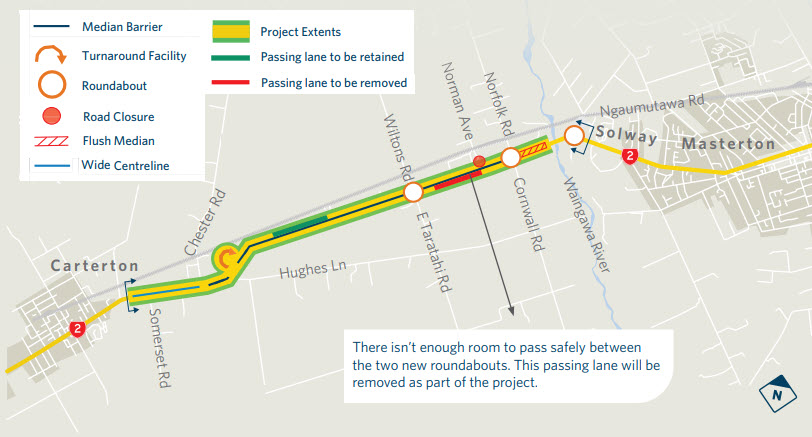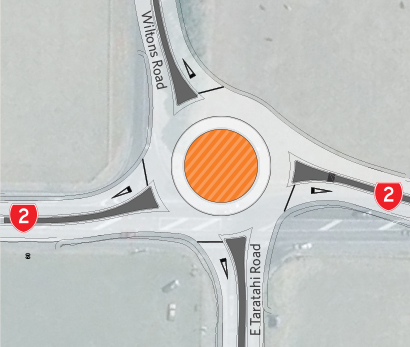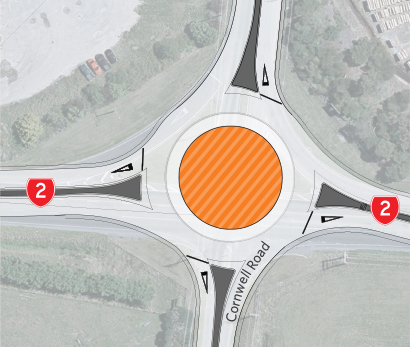Our designs include flexible road safety barriers down the middle of the road to prevent head-on crashes, and new roundabouts at Ngaumutawa Road, Norfolk Road and East Taratahi Road to improve safety at these key intersections. We’re also designing turnaround options around the Clareville Saddlery area.
New roundabouts at Norfolk Road and East Taratahi Road remove the need for intersection speed zones.
We’d like to thank everyone who provided feedback to us during this project. We used this information alongside our research to shape this design.
All changes cater to the needs of all vehicles, including trucks and agriculture vehicles. As we’re not proposing side barriers there will still be room for vehicles to pull over. Over dimension vehicles will be able to lift their loads above the barrier height to travel.
Community engagement
In August and September 2021, we asked for your thoughts on the proposed new roundabouts, flexible safety barriers and turnaround facilities for the stretch of road between Masterton and Carterton. We received over 1300 individual pieces of feedback. We heard from residents and landowners, mana whenua, MPs, local government representatives, local businesses and organisations, and people who use SH2 every day.
Engagement summary [PDF, 258 KB]
Safety improvements
Roundabouts
SH2/Ngaumutawa Rd roundabout
Our design includes a raised pedestrian crossing to make it safer for school children and others to cross the road, and a raised platform to help slow traffic approaching the roundabout. There will also be new pathways for cyclists and pedestrians.
SH2/Wiltons Rd/E Taratahi Rd roundabout
SH2/Norfolk Rd roundabout
Median barriers
Flexible road safety barriers work
Flexible road safety barriers ‘catch’ vehicles that leave their lane before they hit something less forgiving – like other vehicles or roadside hazards such as trees, poles and ditches.
When a vehicle hits a barrier the high-tension wire cables flex, slowing down the vehicle and keeping it upright during and after a collision. The barrier absorbs the impact, reducing the force on the people in the vehicle. Flexible road safety barriers are designed so they don’t penetrate the passenger compartment of a vehicle.
They are also designed so a vehicle is not deflected into another traffic lane. Depending on the speed and angle of the impact, a number of posts may bend over. This is how the posts are designed.
What makes them ideally suited to many New Zealand roads is that they are narrow so can often be installed without significant widening of the road. They are also cost effective and they work – results show a 70–80 percent* reduction in road fatalities.
*2 Johansson, R. (2009) Vision zero – implementing a policy for traffic safety. Safety Science. 47(6), 826-831. doi: 10.1016/j.ssci.2008.10.023
What about motorcyclists?
Some people think the steel ropes are not safe for a rider. Studies have shown this isn’t correct. In fact it’s the opposite. Barriers can reduce the number of motorcyclists killed and injured on our roads by 50 percent.**
**Carlsson, A. (2009). Evaluation of 2+1 roads with cable barrier. Final report. VTI rapport 636A 4 3 8
Flexible road safety barriers explained
Flexible road safety barriers are your safety net
Every day, someone makes a mistake on the road. Barriers offer a second chance, making sure that simple mistakes don’t cost lives.
If you hit a flexible barrier, the steel cables flex, slowing down your vehicle and keeping it upright. They absorb the impact so you and the people with you, don’t.
SH2 southern turnaround
This ‘jug handle’ design gives people a safe place to turn around without crossing two lanes of traffic. It’s designed for a variety of vehicles including large trucks and agriculture vehicles.


 View larger map
View larger map View larger map
View larger map View larger map
View larger map View larger map
View larger map